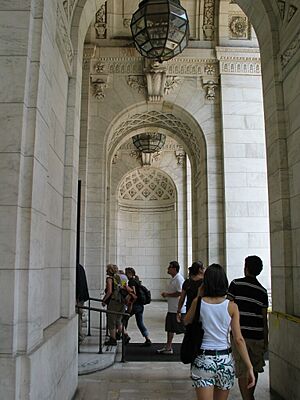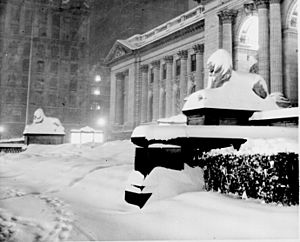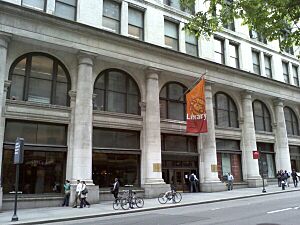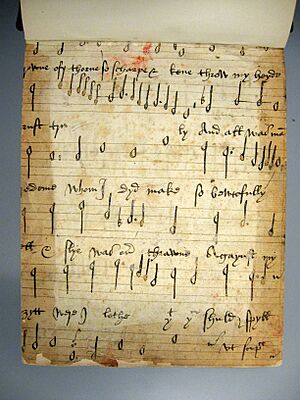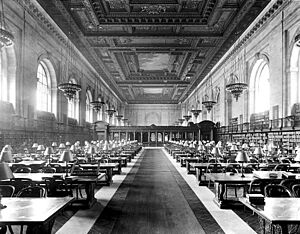New York Public Library facts for kids
Quick facts for kids New York Public Library |
|
|---|---|
 |
|
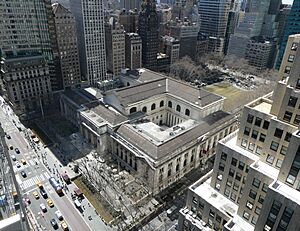 |
|
| The New York Public Library Main Branch in Manhattan | |
| Established | May 23, 1895 |
| Location | 476 Fifth Avenue, New York City, New York, U.S. |
| Coordinates | 40°45′11″N 73°58′55″W / 40.75306°N 73.98194°W |
| Branches | 92 |
| Collection | |
| Size | 55 million |
| Access and use | |
| Population served | 3.5 million (the Bronx, Manhattan, and Staten Island) |
| Other information | |
| Budget | US$302,208,000 (2017) Endowment: $1,448,838,000 |
| Director | Anthony Marx, president and CEO Brent Reidy, Andrew W. Mellon Director of the Research Libraries |
| Staff | 3,150 |
The New York Public Library (NYPL) is a huge library system in New York City. It has almost 53 million items and 92 locations. This makes it the second-largest public library in the United States. Only the Library of Congress is bigger. It is also one of the largest public libraries in the world.
The NYPL is a private, non-profit organization. It gets money from both private donations and public funds. The library has branches in the Bronx, Manhattan, and Staten Island. Other parts of New York City, like Brooklyn and Queens, have their own separate library systems.
The NYPL has two main types of libraries. There are circulating libraries where you can borrow books. There are also research libraries where you can study books and other materials. These research libraries are open to everyone.
The official name of the library is "The New York Public Library, Astor, Lenox and Tilden Foundations". It was created in the 1800s. It combined several smaller libraries. Rich people helped fund it with generous donations.
Many people think of the Main Branch when they hear "New York Public Library". This famous building has two lion statues named Patience and Fortitude. They sit at the entrance. The Main Branch is a very important historical building.
Contents
History of the Library
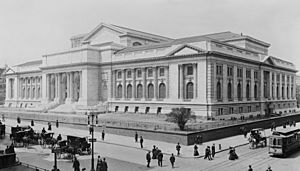
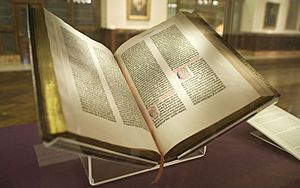
The idea for a public library started with John Jacob Astor. He left money in his will to create a library. After he passed away in 1848, the Astor Library opened in 1854. It was a free library for research, but books could not be taken out.
Later, the Lenox Library was created in 1870. It was built on Fifth Avenue. James Lenox donated many rare books and artworks to this library. This included the first Gutenberg Bible in the Americas. At first, this library also charged money to enter.
Samuel J. Tilden, a former governor, believed New York needed a city-wide library. When he died in 1886, he left most of his money for a free library. This money was held in a trust for several years.
Eventually, people realized that both the Astor and Lenox libraries were having money problems. Most libraries in New York City back then were private. Many charged fees to use them. John Bigelow had an idea to combine the two struggling libraries. Other important people agreed with his plan.
On May 23, 1895, the "New York Public Library, Astor, Lenox and Tilden Foundations" was officially formed. This was seen as a great example of private donations helping the public. John Shaw Billings became the library's first director.
In 1901, Andrew Carnegie offered a large donation. He gave $5.2 million to build 65 new branch libraries. The only condition was that New York City had to run and maintain them. The Brooklyn and Queens library systems did not join the NYPL. They wanted to stay independent.
The NYPL hired famous architects to design the new Carnegie libraries. This helped make sure the buildings looked similar and saved money.
Over the years, the library hired experts to build its collections. They wanted to have a wide range of knowledge from all over the world. The library collected millions of books and other items. The leaders of the library worked to protect it from political problems. They also made sure it had enough money and was well cared for.
During the world wars, the military used the library's maps and books a lot. Library staff helped by finding and copying important maps for war agencies.
Research Libraries
Main Branch Building
The people who started the New York Public Library wanted a grand main building. They chose a central spot on Fifth Avenue. It was built on top of an old water reservoir. John Shaw Billings designed the building. He wanted a huge reading room above seven floors of book stacks. This design helped get books to readers very quickly.
The building was designed in the Beaux-Arts style. It opened on May 23, 1911. It was the largest marble building in the United States at that time.
The two stone lions at the entrance are very famous. They were sculpted by Edward Clark Potter. The main reading room was once the biggest in the world. It is 77 feet wide and 295 feet long, with 50-foot-high ceilings.
In the 1970s and 1980s, more storage space was added. It was built underground, beneath Bryant Park. The building was greatly repaired from 2007 to 2011. A generous gift of $100 million helped pay for this. Today, the main reading room has computers and internet access. It also has special rooms for writers and scholars.
The Main Branch is a very important historical site. It has several special recognitions.
Other Research Branches
In the 1990s, the library decided to move its science, technology, and business collections. They opened the Science, Industry and Business Library (SIBL) in 1995. This library cost $100 million to build. After SIBL opened, the main research library on 42nd Street was renamed the Humanities and Social Sciences Library.
Today, the NYPL has four main research libraries. They hold about 44 million items. The Humanities and Social Sciences Library is still the most important research library. SIBL is the largest public library in the country focused on science and business.
The other two research libraries are the Schomburg Center for Research in Black Culture in Harlem. The other is the New York Public Library for the Performing Arts at Lincoln Center. Some of these research libraries also have books you can borrow.
Recent Changes
The New York Public Library was not created by the government. It has always been a mix of city government and private donations. The research libraries mostly get private money. The branch libraries are mainly funded by the city.
In 2010, the NYPL moved some of its operations to a new building. This is the Library Services Center in Long Island City. A large book sorter machine helps send books to the 132 branch libraries. This machine is very long, like two-thirds of a football field. It can sort 7,500 items every hour. This has made waiting times for books much shorter.
The library also has a special team of security officers. They help keep the libraries safe.
In 2014, the NYPL started a project called "Library Simplified." This project made it easier for people to check out e-books. In 2016, they launched an app called "SimplyE." With this app, you can find and borrow e-books with just a few clicks. The library made the code for SimplyE available for anyone to use.
To celebrate its 125th birthday in 2020, the NYPL listed its most borrowed books. The Snowy Day by Ezra Jack Keats was number one. The Cat in the Hat and Nineteen Eighty-Four were also in the top three.
Until 2021, the NYPL charged late fees for overdue books. But on October 5, 2021, the library stopped charging late fees. All old late fees were also removed from people's accounts.
In November 2023, Sunday services were stopped at some branches. This was due to budget cuts. However, funding for Sunday service was brought back in June 2024.
BookOps: Working Together
In February 2013, the New York Public Library and the Brooklyn Public Library decided to combine their technical departments. This new department is called BookOps. This change was expected to save millions of dollars for both libraries. The Queens Public Library might also join in the future.
BookOps is located in Long Island City. It helps save money and improve service. It handles ordering, cataloging, and preparing new books. Before BookOps, these jobs were done in different places. Books sometimes took two weeks to reach their destination. Now, all departments are in one building. In 2015, BookOps sorted almost eight million items.
Library Debates
Some changes at the library have caused discussions. For example, the library joined the Google Books Library Project in 2004. This project scans public domain books. These books are then available online for free.
Another discussion was about selling the former Donnell Library building. This led to moving children's, young adult, and foreign language collections. The Donnell Media Center was also closed. Its collection was moved to other libraries. The old building was then used for a luxury hotel.
Branch Libraries
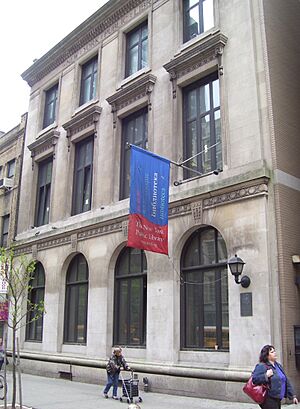
The New York Public Library system has many branch libraries. These are located in the Bronx, Manhattan, and Staten Island. They include the Stavros Niarchos Foundation Library and the Andrew Heiskell Braille and Talking Book Library. The branch libraries are the third-largest library system in the United States.
These libraries offer many collections, programs, and services. This includes the famous Picture Collection at the Stavros Niarchos Foundation Library.
The system has 40 libraries in Manhattan, 35 in the Bronx, and 14 in Staten Island. The newest one is the Charleston Library, which opened on March 16, 2022. As of 2022, the NYPL has 4 research centers and 89 neighborhood branch libraries. All libraries in the NYPL system are free to use for everyone.
As of 2019, the research collections have 46.8 million items. The branch libraries have 9.9 million items. Together, the collections have almost 53 million items. Only the Library of Congress and the British Library have more.
Services for Everyone
ASK NYPL
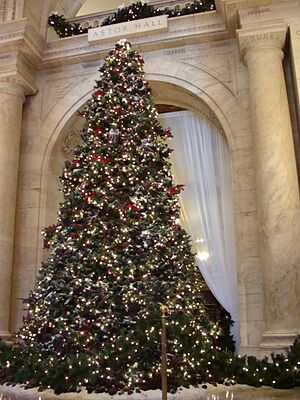
ASK NYPL is a service where you can call or go online to ask questions. They answer about 100,000 questions each year. They even answer questions in The New York Times.
Website and Digital Collections
The library's website lets you search its catalogs and online collections. It also has information about free events, exhibits, and computer classes. You can also find English as a Second Language (ESL) classes.
The website has two online catalogs. LEO searches books you can borrow. CATNYP searches the research collections. If you have a library card, you can ask for books from any branch. They will be sent to your local branch.
With a library card, you can also access thousands of magazines, newspapers, and reference books online. These include major magazines and the New York Times archives. There are also databases for children, teenagers, and adults.
The NYPL Digital Collections has over 900,000 images from the library's collections. Time Magazine called it one of the "50 Coolest Websites" in 2005.
You can download free e-books using the SimplyE app and website. The library also has a "Books for All" program. This program makes some books that have been banned in other parts of the U.S. available to anyone in the country through the SimplyE app. The library also hosts a Teen Banned Book Club.
One NYPL
In 2006, the library started a new plan called "One NYPL." This plan combined the branch and research libraries. They created one online catalog for all collections. Now, one library card can be used at both branch and research libraries.
Community Oral History Project
The NYPL's Community Oral History Project collects stories from people in New York City. This helps document the history of different neighborhoods and people. It includes stories from places like Greenwich Village and Harlem. It also includes stories from different groups, like veterans and people with disabilities.
Community Outreach
The New York Public Library offers many services to its visitors. This includes services for immigrants. The library offers free classes to help with work and life skills. They also have materials and coaching for non-English speakers. Free ESOL (English for Speakers of Other Languages) classes are available.
Since July 2018, NYC library card holders can visit many famous New York museums for free. This includes the Whitney Museum of American Art and the Guggenheim Museum Bilbao.
Temporary Programs
In June 2017, the "Subway Library" was announced. This was a project with the New York Public Library, Brooklyn Public Library, Queens Public Library, and the Metropolitan Transportation Authority. It let New York City Subway riders access e-books and short stories while riding the subway.
How the Library is Run
The NYPL is run by a board of trustees. This board includes the New York City Mayor, the New York City Council Speaker, and the New York City Comptroller. They work together to manage the library.
Other New York City Library Systems
The New York Public Library is one of three separate public library systems in New York City. The other two are the Brooklyn Public Library and the Queens Public Library.
In 2006, all three library systems together had 35 million items borrowed. The NYPL and BPL had 15 million, and Queens had 20 million. In total, the three library systems had 37 million visitors in 2006. Together, they have 209 branches and 63 million items in their collections.
Cultural Importance
The New York Public Library is considered one of the most important libraries in the United States. It is often mentioned alongside the Library of Congress, the Boston Public Library, and the university libraries of Harvard and Yale.
The NYPL also works with other major libraries. It is a founding member of the Research Libraries Group. It also shares an off-site storage facility with Harvard, Columbia, and Princeton universities.
See also
 In Spanish: Biblioteca Pública de Nueva York para niños
In Spanish: Biblioteca Pública de Nueva York para niños
- Education in New York City
- Google Books Library Project
- List of museums and cultural institutions in New York City
- List of New York Public Library branches
- List of presidents of the New York Public Library


